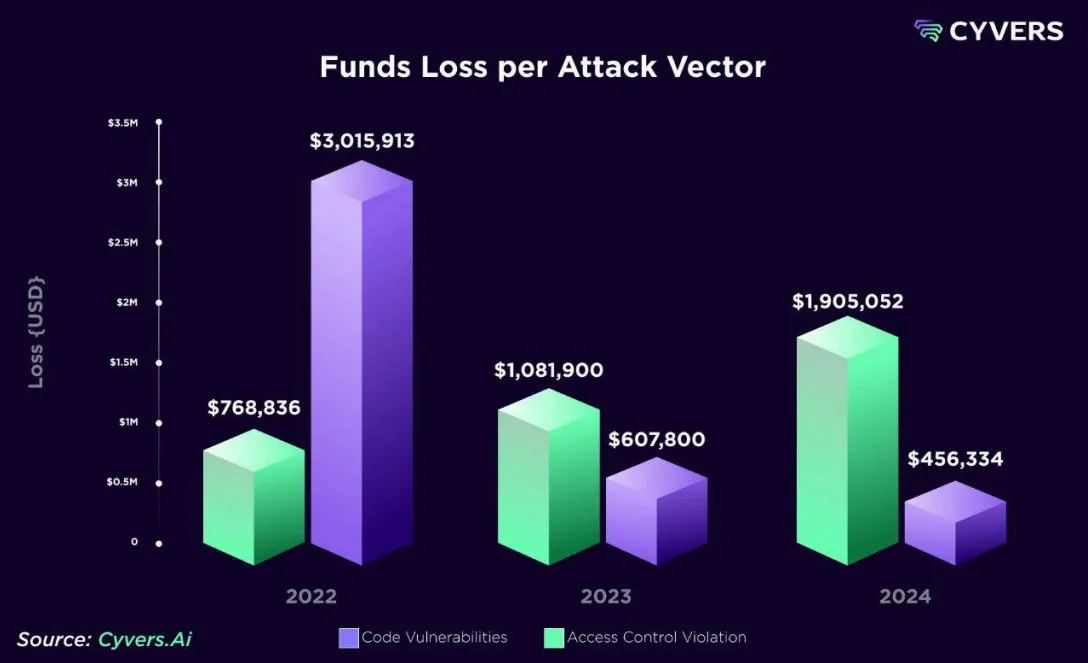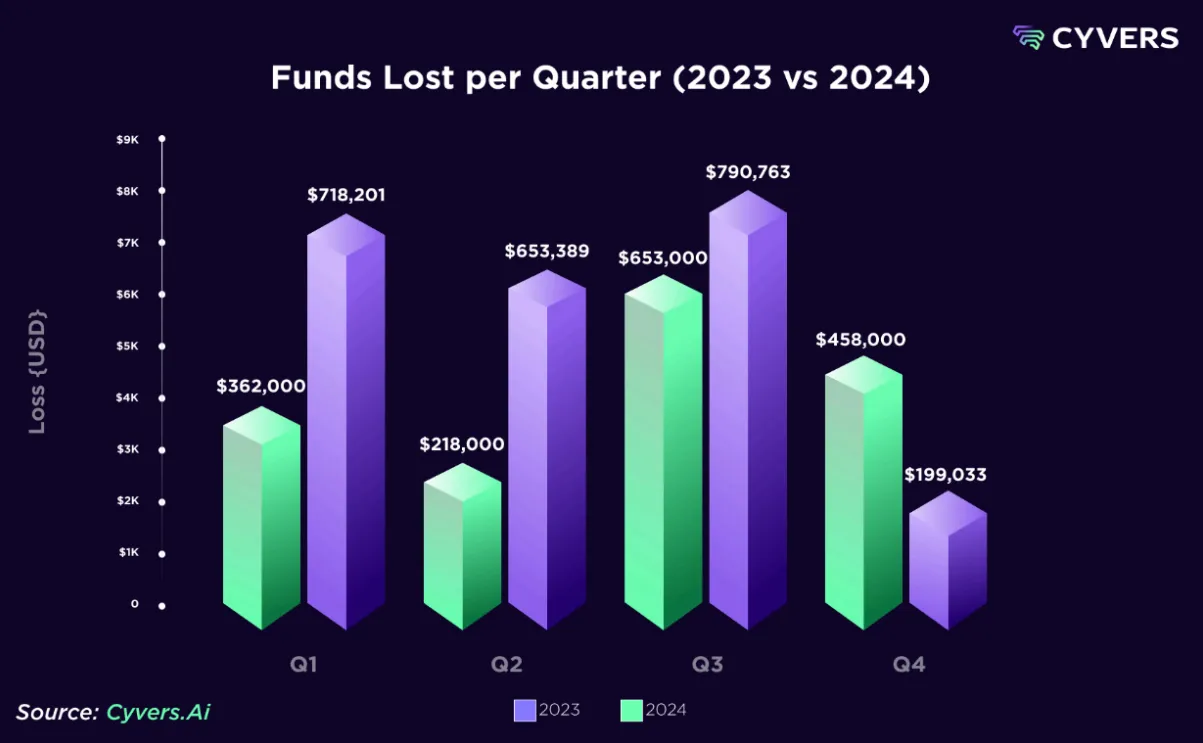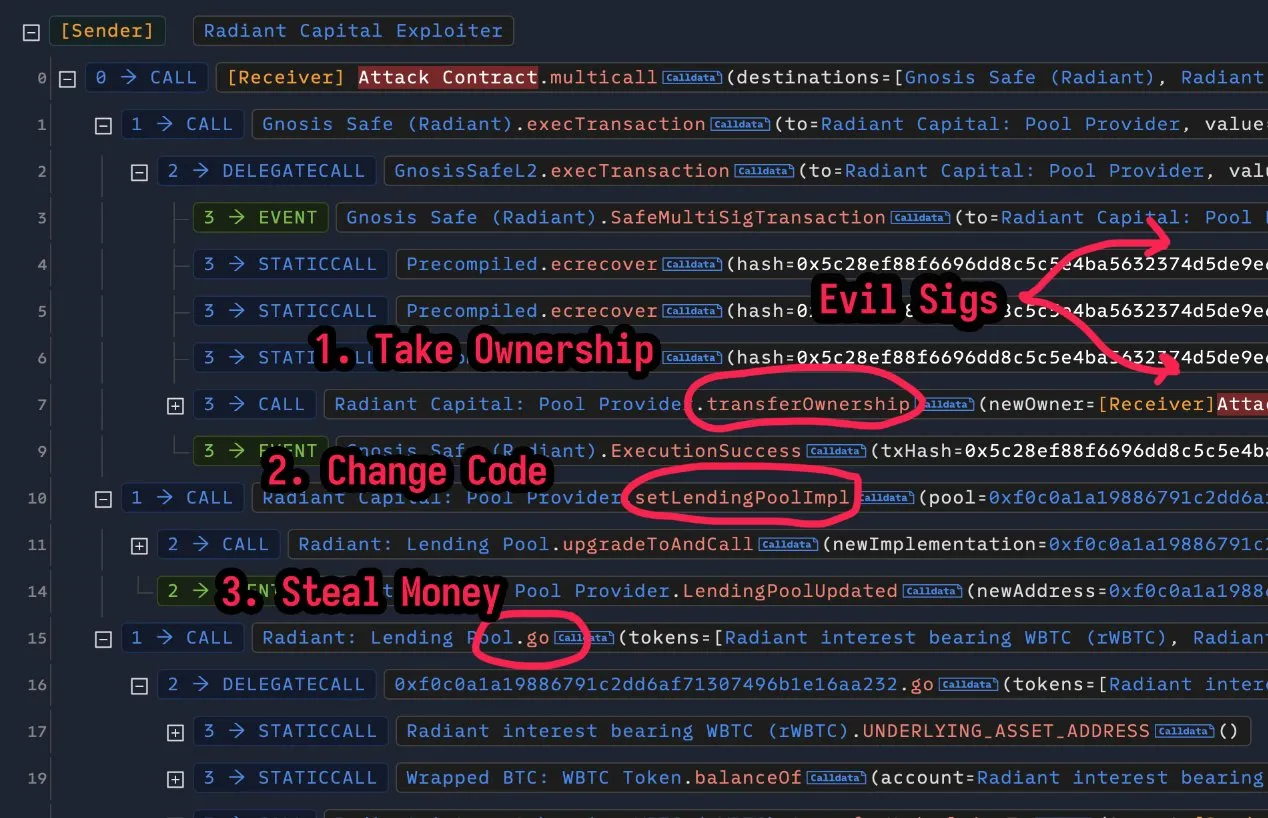Crypto hacks and frauds led to over $2.3 billion in losses this year, highlighting the persistence of security vulnerabilities in the industry. This figure spans 165 incidents, marking a 40% increase from the previous year.
While the total is lower than the $3.7 billion lost in 2022, the continued rise in attacks signals that the industry’s defenses remain inadequate against the advanced threats.
Ethereum and Access Control Failures Dominate Losses
According to Cyvers’ annual report, access control vulnerabilities stood out as a primary driver of losses, responsible for 81% of the total stolen funds.
Although these incidents accounted for just 41.6% of the cases, their outsized impact reflects the dangers of mismanaged security protocols. Ethereum was the most affected blockchain this year, recording over $1.2 billion in losses.

A rather disturbing trend this year was the prevalence of “Pig Butchering” scams. These elaborate fraud schemes swindled over $3.6 billion from unsuspecting users, with most activity concentrated on the Ethereum blockchain.
“The surge in access control breaches and sophisticated scams like Pig Butchering underscores the importance of implementing AI-powered risk assessment, transaction validation, and anomaly detection tools. Security must evolve to stay ahead of increasingly complex and coordinated attack,” Cyvers told BeInCrypto.
Also, smart contract vulnerabilities dominated the attack landscape, particularly in DeFi. The third quarter of 2024 was the worst for losses, with $790 million stolen during this period.
“If crypto platforms want to avoid becoming the next victim of hackers, they need to deploy robust detection and prevention systems and integrate them with their crisis response mechanisms. As Cyvers data shows, 9 out of 10 smart contracts that were hacked were audited and many of them have underwent strict penetration tests. This, clearly, was not enough,” Cyvers researchers noted.
By contrast, Q4 recorded significantly lower activity, suggesting a temporary lull in malicious operations.

Biggest Crypto Hacks of 2024: WazirX, Radiant Capital, and DMM Bitcoin
The year’s largest individual incidents offered stark reminders of the vulnerabilities within the crypto ecosystem.
In July, Indian crypto exchange WazirX suffered a devastating hack, losing approximately $234.9 million. Attackers exploited weaknesses in the exchange’s multisignature (multisig) wallets, gaining unauthorized access to funds.
Multisig wallets, which require multiple private keys for transaction approvals, are often seen as more secure. However, this incident demonstrated how poor implementation of such systems can lead to catastrophic breaches.
WazirX temporarily halted trading and withdrawals to contain the damage and initiated a comprehensive security audit. Despite these efforts, the exchange remains offline as it seeks regulatory approval to resume operations.
“We are striving to obtain the court’s sanction of the Scheme at the earliest feasible timeline. Subject to legal and regulatory requirements, the platform to resume trading post-effective Scheme date,” WazirX recently wrote on X (formerly Twitter).
In November, Indian authorities arrested a suspect linked to the hack, though the mastermind remains at large. Investigators criticized Liminal Custody, a firm responsible for securing WazirX’s digital wallets, for failing to provide critical information during the probe.
Radiant Capital, a prominent blockchain lender, was another high-profile victim this year. In October, the platform lost over $50 million in a multi-chain attack.
Hackers reportedly gained access to three of the platform’s private keys, enabling them to drain assets across several networks, including Arbitrum, Binance Smart Chain, Base, and Ethereum.

The attack has been attributed to North Korean-backed actors, who are increasingly targeting the crypto sector with advanced tactics. Radiant Capital’s breach reflects the heightened risks associated with cross-chain operations and the urgent need for better private key management.
Meanwhile, the Japanese cryptocurrency exchange DMM Bitcoin faced one of the most severe incidents in 2024. In May, the platform lost approximately 4,502.9 Bitcoin, valued at $320 million at the time, after attackers compromised a private key. Despite prolonged efforts to recover stolen assets and reassure customers, DMM Bitcoin announced its closure in December.
The exchange has since begun transferring user accounts to SBI VC Trade, marking a grim conclusion to its operations. The incident highlights the devastating impact of inadequate key security, particularly for centralized platforms.
CeFi Risks and Emerging Threats from Advanced Technologies
Centralized financial platforms (CeFi) continue to face significant challenges. Single points of failure, such as centralized reserves and insufficient oversight of key management, make these platforms attractive targets for attackers.
The reliance on multisignature wallets, which have proven vulnerable under certain conditions, further aggravates these risks. Emerging technologies, including quantum computing and artificial intelligence, are expected to intensify threats by enabling increasingly complex attack methods.
These developments necessitate proactive security measures to keep pace with the dynamic threat landscape. Experts have noted that incidents like the WazirX and Radiant Capital breaches could likely have been avoided with the use of proactive threat monitoring solutions.
“We can assess with certainty that such prominent attacks, like the $235 million WazirX hack and the $50 million Radiant Capital hack could have been avoided and 100% of the funds could have been saved, had the companies used such solutions,” Cyvers told BeInCrypto
The sharp increase in malicious activity this year reflects the critical need for stronger defenses across the cryptocurrency ecosystem. Platforms lacking real-time monitoring and preemptive security tools remain highly vulnerable to breaches, putting user funds at risk.
The industry must prioritize adopting advanced security measures and fostering greater collaboration between stakeholders to address these ongoing threats effectively.
“Zero-day attacks are unpredictable and are not based on previous, known, practices. Without real-time monitoring and detection mechanisms, and pre-emptive tools – crypto platforms can not address such attacks and thwart in real-time,” Cyvers experts noted.
As the crypto sector continues to grow, so too will the ingenuity of attackers seeking to exploit its vulnerabilities. This year’s incidents have made it clear that reactive measures are no longer sufficient.
Disclaimer
In adherence to the Trust Project guidelines, BeInCrypto is committed to unbiased, transparent reporting. This news article aims to provide accurate, timely information. However, readers are advised to verify facts independently and consult with a professional before making any decisions based on this content. Please note that our Terms and Conditions, Privacy Policy, and Disclaimers have been updated.









